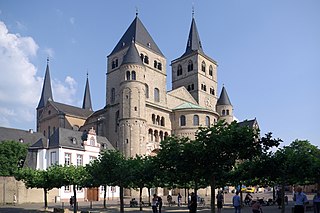Adalbero or Adalberon is a masculine given name, a variant of Adalbert, derived from the Old High German words adal ("noble") and beraht ("bright") or bero ("bear"). It may refer to:
Saint Albert or St. Albert may refer to:

Sigebert of Gembloux was a medieval author, known mainly as a pro-Imperial historian of a universal chronicle, opposed to the expansive papacy of Gregory VII and Pascal II. Early in his life he became a monk in the Benedictine abbey of Gembloux.
Reginald I was Count of Bar (1105–1149). Barrois, during the Middle Ages, was the territory of the counts and dukes of Bar, in the eastern part of present-day France, bordering Lorraine.

Albero de Montreuil was Archbishop of Trier from 1132 to 1152 and is the subject of the Gesta Alberonis.

Adalbero of Würzburg was Bishop of Würzburg and Count of Lambach-Wels.
Louis of Lower Lorraine, Frankish royalty and a member of the Carolingian dynasty, was a younger son of Charles, Duke of Lower Lorraine, through his second wife, Adelaide.
Sigfried was Count in the Ardennes, and is known in European historiography as founder and first ruler of the Castle of Luxembourg in 963 AD, and ancestor and predecessor of the future counts and dukes of Luxembourg. He was also an advocate of the abbeys of St. Maximin in Trier and Saint Willibrord in Echternach.

The Bishopric of Verdun was a state of the Holy Roman Empire. It was located at the western edge of the Empire and was bordered by France, the Duchy of Luxembourg, and the Duchy of Bar.
Alpert of Metz was a Benedictine chronicler of the eleventh century. His De diversitate temporum is a major source for the history of Western Europe in the period it covers, which is 990 to 1021. It was dedicated to Burchard of Worms.

Simon III of Sarrebrück, Simon III von Saarbrücken (Saarbrücken-Leiningen) was the Count of Saarbrücken (de) from 1207 until his death, about 1240.

The Diocese of Trier, in English traditionally known by its French name of Treves, is a Latin Church ecclesiastical territory or diocese of the Catholic church in Germany. When it was the archbishopric and Electorate of Trier, it was one of the most important states of the Holy Roman Empire, both as an ecclesiastical principality and as a diocese of the church. Unlike the other Rhenish dioceses—including Mainz and Cologne–Trier was the former Roman provincial capital of Augusta Treverorum. Given its status, Trier has continuously been an episcopal see since Roman times and is one of the oldest dioceses in all of Germany. The diocese was elevated to an archdiocese in the time of Charlemagne and was the metropolitan for the dioceses of Metz, Toul, and Verdun. After the victory of Napoleon Bonaparte of France, the archdiocese was lowered to a diocese and is now a suffragan in the ecclesiastical province of the Archdiocese of Cologne. The diocesan cathedral is the Cathedral of Saint Peter. The Cathedral Chapter retains the right to elect the bishop, rather than selection by papal appointment.
Giselbert of Luxembourg was count of Salm and of Longwy, then count of Luxemburg from 1047 to 1059. He was a son of Frederick of Luxembourg, count of Moselgau, and perhaps of Ermentrude of Gleiberg.
The County of Metz originated from the frankish Metzgau. In the second half of the 9th century it went to the Gerhardiner (de), which held at the same time the County of Paris.
Adalbero III of Luxembourg was a German nobleman. He was a titular Count of Luxembourg and Bishop of Metz.
Gozlin, was count of the Ardennes and the Bidgau, and army commander for his brother, Adalbero I of Metz.
Adalbero I of Metz was an important member of the clergy during the middle years of the tenth century, serving as Bishop of Metz from 929 till 954.
Adalbero II of Metz was a Catholic bishop of the 10th and 11th centuries. From 984 until his death he was the bishop of Verdun and bishop of Metz. He was the son of Frederick I, Duke of Upper Lorraine and Beatrice of France, daughter of Hugh the Great.

Beatrice of France or Beatrice of Paris was Duchess consort of Upper Lorraine by marriage to Frederick I, Duke of Upper Lorraine, and regent of Upper Lorraine in 978-980 during the minority of her son Thierry I.
This page is based on this
Wikipedia article Text is available under the
CC BY-SA 4.0 license; additional terms may apply.
Images, videos and audio are available under their respective licenses.






